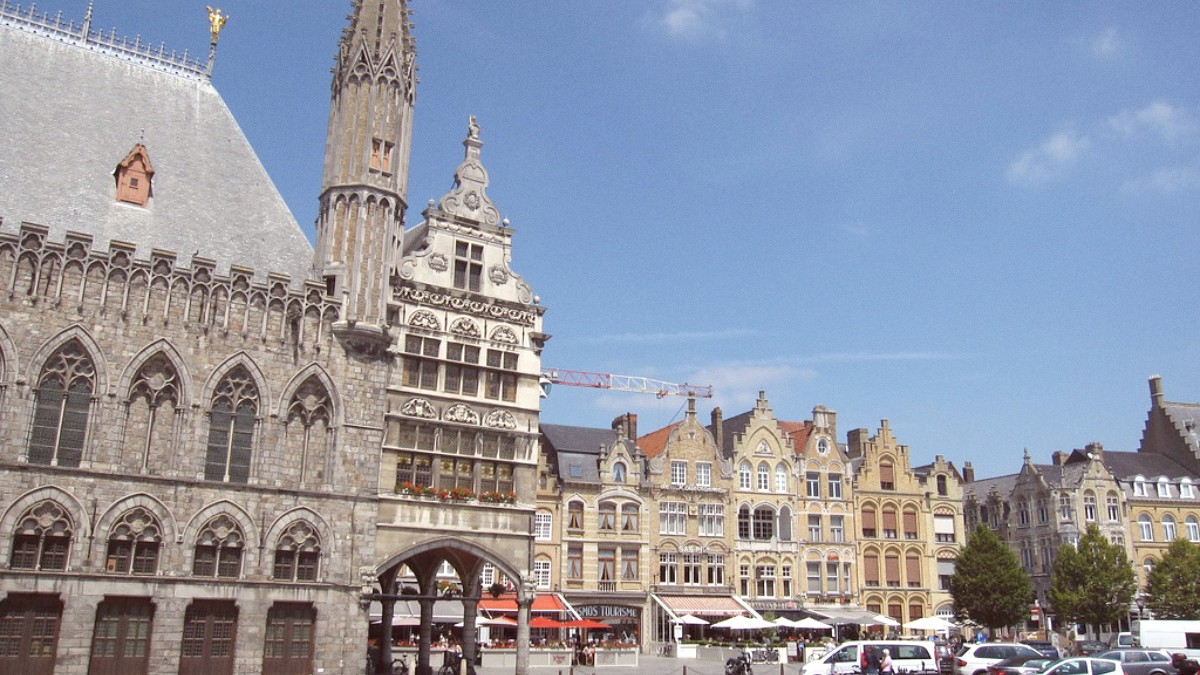
Flanders, Belgium
The Cloth Hall and Belfry are UNESCO World Heritage sites, symbolizing Ypres's medieval wealth and resilience. Meticulously rebuilt after WWI, it houses the In Flanders Fields Museum.
The Menin Gate Memorial dedicates itself to British and Commonwealth soldiers who died in the Ypres Salient during WWI with no known grave. Names of over 54,000 missing soldiers are inscribed on its walls.
Ypres Salient has preserved WWI trenches (Bayernwald, Sanctuary Wood/Hill 62) and craters (Pool of Peace/Spanbroekmolen Crater). These are open-air historical sites.
The Ypres city center, rebuilt after WWI, presents historical reconstruction. The architecture faithfully replicates the pre-war Flemish style.
St. Martin's Cathedral, rebuilt after WWI, dominates the skyline. Numerous smaller churches throughout the Ypres Salient, many rebuilt or scarred, are places for reflection.
Countless Commonwealth War Graves Commission Cemeteries (Tyne Cot, Essex Farm, Langemark German Cemetery) dot the landscape. National memorials exist for various forces (The Brooding Soldier, Island of Ireland Peace Park).
Military heritage, including WWI battlefields, bunkers, and trenches, defines the region.
Beyond its historical weight, the Ypres region presents green spaces and scenic viewpoints for relaxation and appreciation of the Flemish landscape.
Ypres Ramparts: The green belt surrounding the city, ideal for walking and jogging, with remnants of old fortifications.
Combines an amusement park and a zoo, for family-friendly entertainment. A short drive east of Ypres.
Highest point in West Flanders, presenting panoramic views over the Westhoek region. Holds WWI historical significance.
Provides a bird's-eye view of Ypres, highlighting the city's unique layout.
Rural areas and nature reserves (Palingbeek, Gasthuisbossen) offer opportunities for birdwatching and local wildlife observation.
The Ypres Salient is flat, with strategic hills like Kemmelberg and Messines Ridge.
Ypres is inland; water sports are not a focus. The Belgian coast (De Panne, Oostende) is 45-60 minutes' drive for beach activities.
Large-scale wildlife safaris do not occur in this region.
No significant lakes or rivers for recreational activities exist directly in Ypres.
Discover some of Ypres's less-visited treasures. These hidden gems present unique perspectives and quieter moments of discovery away from the main tourist paths.
Capture the solemn beauty of the Last Post ceremony at Menin Gate, with respect for the occasion. Document the meticulously maintained rows of headstones at Tyne Cot Cemetery during sunrise or sunset for impactful images.
Photograph panoramic views from the Kemmelberg or the Belfry. Capture reflections in the Pool of Peace.
To plan your visits seamlessly, consider booking tickets in advance. GetYourGuide helps discover and reserve tours and activities.
Many visitors come to Ypres for its WWI battlefield sites. Guided tours enhance the experience significantly.
Beyond the main highlights, many smaller, yet poignant, sites offer a connection to the history of the region.
A well-planned itinerary maximizes your time in Ypres and its surrounding historical landscape.
Ypres and its surroundings are a profound memorial. The region's meticulous rebuilding after WWI demonstrates resilience and respect for those who served.
Museums and memorials provide an educational and moving experience, for understanding WWI's impact.
The peaceful natural spaces, once battlegrounds, invite contemplation and remembrance.
Photography at these sites captures their enduring power and beauty, while respecting their solemn purpose.
Known as the "Hop Capital," home to Talbot House (WWI site) and local breweries. It has a quieter, less commercial experience.
Visit Poperinge TourismSouth of Ypres, this area features rolling hills and vineyards, presenting beautiful scenery for walking and cycling.
Explore HeuvellandLocated in Ploegsteert, this visitors' center provides further insight into the Christmas Truce and the southern sector of the Salient.
Discover PlugstreetThe largest Commonwealth War Graves Commission cemetery, a profoundly moving site near Passchendaele.
Visit CWGC SiteMaximize your visit by utilizing comprehensive planning resources.
Engaging with the history of Ypres extends beyond simple observation. It calls for deep consideration.
Wear comfortable walking shoes, as many sites involve walking. Many cemeteries and memorials are open-air and exposed to weather.
For GetYourGuide, note that availability and prices vary depending on the season and specific tour. Booking ahead often secures your spot.
Ypres presents an unique blend of history, culture, and nature. A thoughtful approach to sightseeing makes your experience more meaningful.
Each museum presents a distinct perspective on the war, offering comprehensive understanding.
Consider purchasing a joint ticket if visiting multiple museums to save money.
The cemeteries are places of quiet contemplation, honoring the fallen.
Remember to maintain a respectful demeanor during your visits.
Wear appropriate footwear for uneven terrain and bring water.
Many schools organize trips to Ypres for students to learn about WWI firsthand.
Numerous historical societies and veteran associations visit the battlefields regularly.
Archives and libraries in Ypres hold extensive resources for researchers and historians.